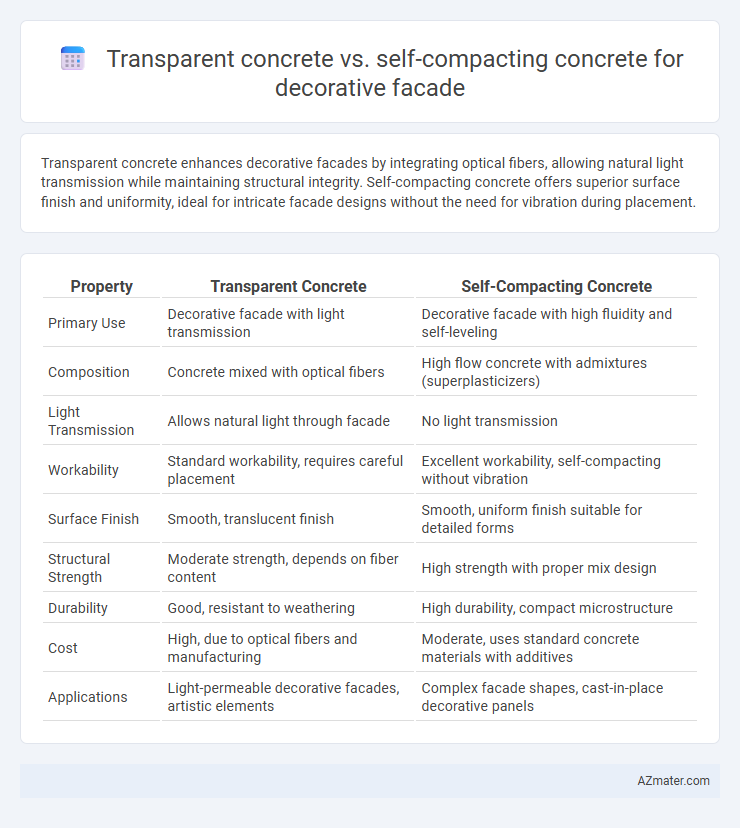Transparent concrete enhances decorative facades by integrating optical fibers, allowing natural light transmission while maintaining structural integrity. Self-compacting concrete offers superior surface finish and uniformity, ideal for intricate facade designs without the need for vibration during placement.
Table of Comparison
| Property | Transparent Concrete | Self-Compacting Concrete |
|---|---|---|
| Primary Use | Decorative facade with light transmission | Decorative facade with high fluidity and self-leveling |
| Composition | Concrete mixed with optical fibers | High flow concrete with admixtures (superplasticizers) |
| Light Transmission | Allows natural light through facade | No light transmission |
| Workability | Standard workability, requires careful placement | Excellent workability, self-compacting without vibration |
| Surface Finish | Smooth, translucent finish | Smooth, uniform finish suitable for detailed forms |
| Structural Strength | Moderate strength, depends on fiber content | High strength with proper mix design |
| Durability | Good, resistant to weathering | High durability, compact microstructure |
| Cost | High, due to optical fibers and manufacturing | Moderate, uses standard concrete materials with additives |
| Applications | Light-permeable decorative facades, artistic elements | Complex facade shapes, cast-in-place decorative panels |
Introduction to Innovative Concrete Technologies
Transparent concrete incorporates optical fibers or resin to allow light transmission, enhancing aesthetic appeal and natural illumination in decorative facades. Self-compacting concrete flows easily into complex molds without vibration, ensuring smooth, defect-free surfaces ideal for intricate facade designs. Both innovative technologies improve architectural flexibility and visual impact while addressing durability and ease of installation in modern construction.
Overview of Transparent Concrete
Transparent concrete integrates optical fibers within its matrix, allowing natural light to pass through while maintaining structural strength, making it ideal for luminous decorative facades. This innovative material enhances aesthetic appeal and energy efficiency by diffusing daylight in architectural designs. Its translucency differentiates it significantly from self-compacting concrete, which prioritizes fluidity and ease of placement rather than light transmission.
Overview of Self-Compacting Concrete
Self-compacting concrete (SCC) is a highly flowable material designed to fill formwork and encapsulate reinforcement without the need for vibration, making it ideal for complex architectural facades. Its ability to produce smooth, high-quality surfaces enhances the aesthetic appeal of decorative facades while maintaining structural integrity. SCC's unique rheological properties enable the creation of intricate designs and textures, offering versatility that complements transparent concrete's light-transmitting qualities in facade applications.
Key Differences in Material Composition
Transparent concrete incorporates optical fibers embedded within a fine concrete mix to allow light transmission, creating illuminated facades. Self-compacting concrete consists of highly flowable cementitious materials with chemical admixtures such as superplasticizers, enabling it to fill formwork without mechanical vibration. The key difference lies in transparent concrete's integration of light-transmitting elements versus self-compacting concrete's focus on fluidity and homogeneity for smooth, defect-free decorative surfaces.
Aesthetic Advantages for Decorative Façades
Transparent concrete enhances decorative facades by integrating optical fibers or resin elements, allowing natural light to pass through while maintaining structural integrity, creating dynamic lighting effects and visual depth. Self-compacting concrete offers smooth, uniform surfaces with high consistency and eliminates the need for vibration, enabling intricate textures, sharp details, and seamless finishes ideal for complex facade designs. Both materials elevate facade aesthetics, with transparent concrete excelling in light transmission and self-compacting concrete providing superior surface quality and design flexibility.
Structural Performance Comparison
Transparent concrete offers a unique balance of light transmission and structural integrity, utilizing optical fibers embedded within the concrete matrix to maintain load-bearing capacity while enhancing aesthetic appeal. Self-compacting concrete (SCC) excels in flowability and homogeneous compaction without segregation, providing superior surface finish and complex shape adaptability in decorative facades. While transparent concrete may have slightly lower compressive strength compared to SCC, its innovative design enables sufficient structural performance combined with translucency, making it ideal for applications where light diffusion and visual impact are prioritized.
Light Transmission vs. Surface Finish
Transparent concrete offers superior light transmission by embedding optical fibers, allowing natural light to penetrate interiors while maintaining structural integrity, making it ideal for decorative facades that emphasize illumination. Self-compacting concrete provides a smoother, more uniform surface finish due to its highly flowable mix, which enhances aesthetic appeal and reduces the need for extensive surface treatment. For facades prioritizing light diffusion, transparent concrete excels, whereas self-compacting concrete is preferred for seamless, clean finishes with enhanced texture control.
Installation and Construction Practices
Transparent concrete offers a unique aesthetic appeal for decorative facades, allowing natural light transmission while requiring precise integration of optical fibers during casting, which demands meticulous installation and alignment practices. Self-compacting concrete (SCC) simplifies construction with its high fluidity and ability to fill complex formworks without vibration, reducing labor and accelerating installation times for intricate decorative facade designs. Both materials necessitate specialized handling: transparent concrete requires controlled curing to maintain light permeability, whereas SCC relies on optimized mix design and formwork stability to achieve uniform surface finishes.
Durability and Maintenance Considerations
Transparent concrete offers unique aesthetic appeal with embedded optical fibers but may exhibit lower durability under harsh environmental conditions compared to self-compacting concrete, which provides superior mechanical strength and resistance to cracking due to its dense microstructure. Self-compacting concrete requires minimal maintenance because of its uniformity and reduced permeability, enhancing longevity for decorative facades exposed to weathering and pollutants. Transparent concrete demands careful handling and sealing treatments to maintain clarity and prevent deterioration, making maintenance more intensive over time relative to the robust performance of self-compacting alternatives.
Cost and Sustainability Analysis
Transparent concrete offers a unique aesthetic for decorative facades by integrating optical fibers, resulting in higher initial costs due to specialized materials and manufacturing processes compared to self-compacting concrete (SCC). SCC provides cost efficiency through reduced labor and faster construction times while maintaining sustainability by minimizing cement content and waste. From a sustainability perspective, SCC's lower carbon footprint and recyclability make it more environmentally favorable, whereas transparent concrete's niche appeal may justify higher costs in iconic architectural projects.

Infographic: Transparent concrete vs Self-compacting concrete for Decorative façade
 azmater.com
azmater.com